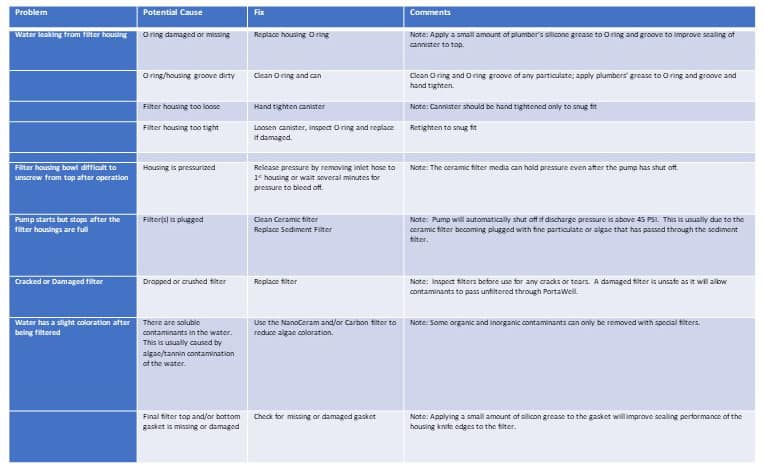Operating instructions
Congratulations on your purchase of the PortaWell® Emergency Water Filtration Appliance. This patented system is made in the USA and is designed to provide an affordable and efficient method for filtering potentially harmful contaminants (both biological and chemical) from a non-potable water source in an emergency or off-grid camping situation to make it suitable for human consumption.
PortaWell comes in one of three different configurations and this guide includes operation instructions for all PortaWell appliances.
- PortaWell Starter Kit
- PortaWell Mini Expedition
- PortaWell Triple
(Rev 16 – 02/06/24)
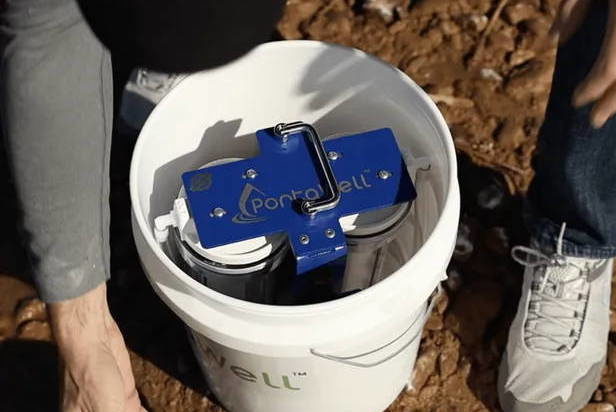
Introduction
PortaWell is an appliance that can be configured with different filters combinations to make most non-potable water sources safe for human consumption.
The PortaWell design provides the following:
- It (PortaWell Starter Kit) is compact and portable (weighs less than 10 lbs.)
- It (PortaWell Starter Kit) is designed to fit in a standard 5-gallon dual purpose bucket for ease of storage or transport.
- They use standard commercially available 10-inch (5-inch for Mini) filters that can be tailored to specific contaminants needing removal.
- They provide multi-stage filtration for effective removal/reduction of most common water borne contaminants.
- A small 12-volt battery (not included) that is rated a minimum of 5 to 10 Amp hour can be used to power the PortaWell®. A 50-watt solar panel (not included) can be used to recharge the battery or extend the battery pumping time.
- It effortlessly provides up to 1 gallon per minute flow rate allowing a larger volume of water to be processed than alternative gravity fed or mechanically pumped systems.
Precautions
- Use good judgement when selecting a water source to be filtered and always seek the best fresh water source available. Avoid water sources that are obviously contaminated with chemicals, heavy sediment, algae bloom, and/or biological waste (animal or human) products. If viral contamination of the water is suspected, consider post treatment of the water with a chlorine solution and let sit for 30 minutes before drinking.
- The pump is not designed for continuous duty operation. To extend the life of the pump, best practice is to operate for up to 30 minutes and rest for 5 minutes. If the ambient temperature is above 90 degrees F, reduce the operating time and extend the rest times accordingly.
- Do not store the PortaWell® Emergency Water Filtration System in below freezing conditions unless the system has been winterized to remove all water from the filter housings, transfer tubes and pump.
- Do not store the PortaWell® Emergency Water Filtration System in direct sunlight. This is to prevent deterioration of the filter housing.
- Do not pump anything other than water through the PortaWell® Emergency Water Filtration System.
- Do not power the PortaWell® Emergency Water Filtration System with any source other than 12 volts. Solar panel (if used) should be connected to a battery and battery to the PortaWell® system. A 110 volt to 12-volt @5 amp transformer (optional) may be used to power the PortaWell® system.
- Do not operate the pump without the screen inlet filter. This is to prevent debris from entering the pump.
- Do not store the PortaWell® system with water in the filter housings for more than 72 hours. This is to prevent any algae buildup.
- Do not use with a damaged or cracked filter cartridge. Use care in handling the ceramic filter as it is fragile and easily broken.
- Make sure that gaskets are present on both top and bottom of filters except for sediment filter which does not require rubber gaskets.
Setup - Filter Installation
The PortaWell is compatible with standard 2 ½ inch by 10-inch (5 inch for Mini) filters that can be configured to reduce sediment and particulate (sediment prefilter), pathogenic bacteria and cysts (ceramic or NanoCeram filter), and organic chemicals and chlorine (activated carbon filter). Other specialty filters may be purchased and installed to remove other contaminants (i.e., heavy metals, tannins, fluoride) that may be present.
- Wash hands before handling filters.
- Installation of OBE (Open Both Ends) filters
- Remove filter housing by unscrewing the transparent cannister bowl from the top and remove from the PortaWell. Take care not to lose or damage the bowl O-ring.
- Remove the filter from the packaging and place (with gaskets) into the bowl and over the bottom sealing protrusion. Orientation of the OBE filter does not matter as there is no top or bottom.
- Reinstall the bowl to the housing top. Move the bowl around until the top of the filter engages the top protrusion making sure the sealing washer is still intact. (If bowl will screw into the housing top, the filter is securely installed)
- Hand tighten the bowl to the housing. A small amount of plumber’s silicon grease on o rings and gaskets ensures a secure fit.
Operation
- Place the PortaWell on a stable level surface.
- Attach the clear plastic inlet tubing to the inlet barb of the pump. Tubing is attached by pressing the tubing onto the barb. The inlet tubing has the screen filter on one end. A clamp may be used on the pump barb to prevent air leaking into the pump inlet.
- Attach the clear plastic outlet tubing to the outlet barb of the filter housing. Tubing is attached by pressing the tubing onto the barb. A clamp is not necessary because this is a low-pressure fitting. Note: Use caution to keep the outlet tubing clean and free of any contamination as this is used to transfer the clean, filtered water to the potable water storage container. Do not interchange the inlet and outlet tubing.
- Place the end of the outlet tubing into a clean container. Best practice is to use a food grade rated container that has a lid to store and transport the filtered water.
- Place the end of the inlet tube (end with the small screen filter) into the non-potable water source. Best practice is to bucket the water from the source (stream, river, lake, pond etc.,) and then pump from the bucket.
- Connect the power pigtail to the pump.
- When ready to begin pumping, affix the alligator clamps to the battery taking care to connect red clamp to the positive battery terminal and black clamp to the negative battery terminal and switch the PortaWell to the on position.
Note: Maximum operating pressure of the pump is 45 PSI. If pump fails to run continuously when switched on, it is usually because a filter has been plugged and needs to be cleaned or replaced before proceeding.
Note: Choose the source water carefully. Source water that contains large quantities of particulate such as sediment, silt or especially algae can cause premature clogging of the ceramic filter pores and ultimately will reduce the useful life of the filter. The ceramic filter is designed to efficiently remove submicron contaminants but if the source water also contains visible particulate (especially algae), these larger particles may quickly load up the ceramic filter to where the pump stops, and the ceramic filter requires cleaning.
Storage
When the PortaWell® Emergency Water Filtration System will not be operated for more than 72 hours, it is important to remove the water from the filter housings and filters to prevent possible algae growth.
- Run the pump to expel as much water as possible from the housing. (Pump can be run dry with no damage)
- Remove the housings and the filters from the PortaWell® system.
- Empty the filter housings of any residual water. Take care to not let any unfiltered water in the housing come in contact with the inside (clean side) of the filter.
- Shake any residual water from the water filters.
- Air dry the housings and filters for 24 hours or until all residual water is evaporated.
- Remove the tubing between the outlet of the pump and the inlet filter housing to drain any excess water.
- Reinstall filters and housings.
Note: Care must be taken when removing the ceramic or NanoCeram filter for storage that the inside of the filter (clean side) does not become cross contaminated with water from the outside (unfiltered side). Best practice is to rinse the housings and ceramic filter in a 500 ppm chlorine bleach solution for 10 minutes before air drying and storage. Four tablespoons bleach per 1 gallon water will give a 500+ ppm disinfecting solution.
Limited Warranty
Your PortaWell® Emergency Water Filtration System is warranted to be free from defects in materials and workmanship for 1 year from the date of purchase.
In the event of a defect in material or workmanship within the 1-year warranty period, WaterMill, LLC will either repair, replace or refund the purchase price of your PortaWell® system at the discretion of WaterMill, LLC.
The warranty does not cover any damage caused by product misuse, abuse, or failure to follow instructions. The warranty does not cover damage to, breakage or fouling of filters.
For Service Contact: Customer Service Tel. 435-527-5272 or support@myportawell.com
Disclaimer: WaterMill, LLC has no Liability (and there is no Basis for any present or future action, suit, proceeding, hearing, investigation, charge, complaint, claim, or demand against it giving rise to any Liability) arising out of any injury to individuals or property as a result of the ownership, possession, or use of any product sold, leased, distributed, or delivered by WaterMill, LLC
PortaWell® Quick Start Guide
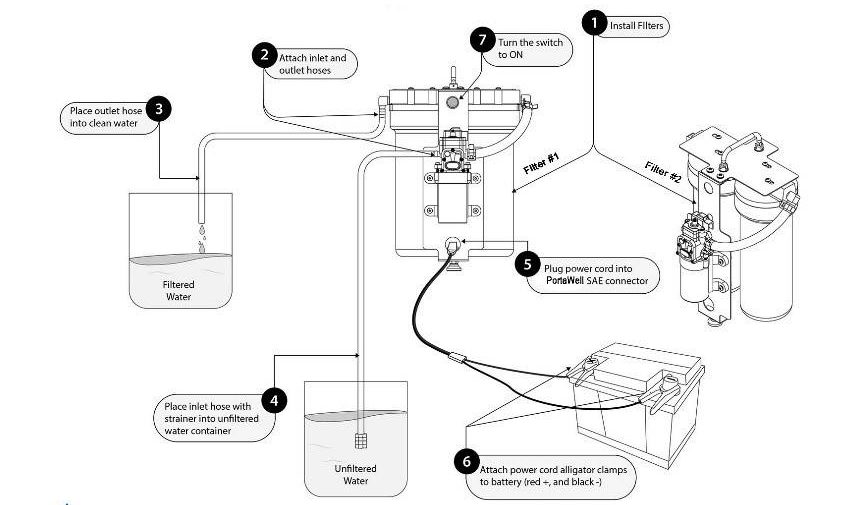
Supplied Filters With PortaWell Systems
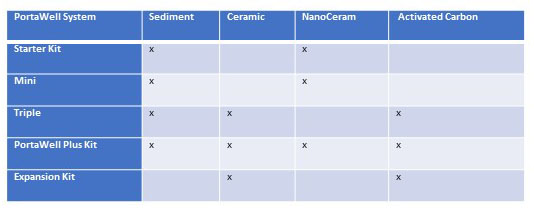
Supplied Filter Characteristics
- Sediment Filter Melt blown spun polypropylene.
- Operating Temperature ————————-40 to 180 degrees F
- Pore Size (Nominal Rating)……………….…….1 micron
- Replacement——1000 gallons or upon filter noticeable flow restriction
- Contaminant removal——silt, sand, organic debris
- Ceramic Filter Meets NSF Standards 42 and 53 Silver impregnated to prevent bacteria growth
- Pore Size (Absolute rating)………………………………. 0.5 micron
- Maxim working temperature…………………………….100 degrees F
- Recommended flow rate………………………………… .3 to 1 gpm
- Recommended cleaning frequency………. when flow is noticeably lower
- Contaminant removal
- Pathogenic bacteria: Cholera, Typhoid, Salmonella, Serratia, Fecal Coliform >99.99% E coli – 100%
- Cysts: Cryptosporidium Parvum, giardia Lamblia – 100%
- Sediment: Down to .8 micron – 100% .3 to .8 micron >99.99% Turbidity > 99.97%
- Metals: Iron, Aluminum
- NanoCeram Filter NSF/ANSI 42 & 53 Certified
- Pore Size (Absolute rating) …………………………… 0.2 microns
- Operating Temperature……………………………. 39-140 degrees G
- Recommended flow rate…………………………. < 10 gpm
- Replacement——————————–Terminal Pressure Drop 35 psi.
- Contaminant Removal
- Pathogenic bacteria, cysts, virus, endotoxins, chlorine
- >99.99% efficiency at .2 microns (latex spheres)
- >3 LRV cyst retention
- <.01 NTU until terminal pressure: 35 PSI
- Activated Carbon 5-micron Coconut Shell Carbon block
- Pore size (Nominal rating) ……………………………… 5 microns
- Maximum Working pressure…………………………….80 psi
- Maximum Operating temperature………………100 degrees F
- Flow rate…………………………….1 gpm
- Replacement……………………….1500 gallons
- Contaminants
- Reduces Chlorine, Insecticides, Benzene, Tastes, Odors and other Organic Chemicals
Note: Care must be taken when removing the ceramic filter for storage that the inside of the filter (clean side) does not become cross contaminated with water from the outside (unfiltered side). Best practice is to rinse the housings and ceramic filter in a 1% chlorine bleach solution for 10 minutes before air drying and storage. 2 tablespoons bleach per 1-quart water will give a 1000+ ppm disinfecting solution
Selection of Filter and Filter Sequence
Note: This table is for information only and it is the responsibility of the user to select the appropriate water source and filter setup as some water sources may have additional contaminants than shown below. This table can be adapted for use with the two filter, three filter (PortaWell Triple) and 4 filter (PortaWell with Expansion Kit) systems.
Contaminant Categories
- Biologic
– Bacteria, Cysts (>0.5 to 1-micron diameter)
– Virus (< 0.5-micron diameter) - Organic Chemical
– Pesticides
– Total Organic Carbon, Industrial Solvents,
– Aromatic compounds
– Algae color and cyanobacteria toxins - Organic Plant
– Algae, Moss, plant/animal decay - Inorganic Chemicals
– Chlorine - Sediment
– Dirt, silt, sand
Treatment Purpose/Filter sequence
- Chlorination Treatment (used to disinfect with high levels of pathogenic bacteria and virus are present.
- Sediment Filter (Used to remove particulate >1 microns).
- Ceramic Filter (Used to remove/reduce 0.5 to 1-micron biologic contaminants including giardia, crypto and bacteria).
- NanoCeram Filter (Used to remove 0.2 biologic contaminants including giardia, crypto, bacteria, virus >0.2 microns).
- Activated Carbon Filter (Used to reduce volatile organic chemicals, toxins, and chlorine).
Note: The filters listed above do not remove inorganic dissolved solids such as magnesium and calcium (hard water). They also do not remove salt from seawater.
Water Contamination Filter Selection Guide
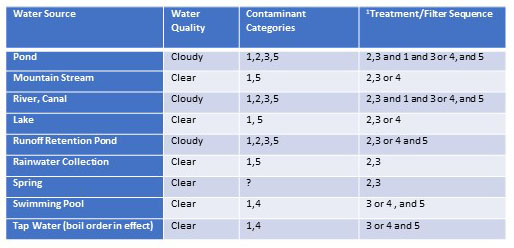
In cases where water source is heavily laden with multiple contaminants, it may be necessary to filter the water twice, changing filter types between treatments based on the table above.
Note: Best practice is to always place the activated carbon filter after the ceramic or Nanoceram filter. This prevents the carbon filter from becoming potentially contaminated and prevents premature fouling of the ceramic filter due to shedding of small carbon particles during the initial phase of filtration. The activated carbon filter does not remove/reduce bacteria and cysts.
Trouble Shooting Guide
